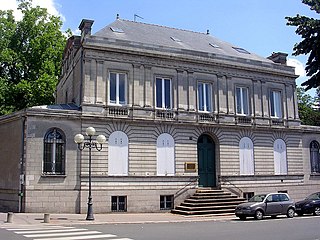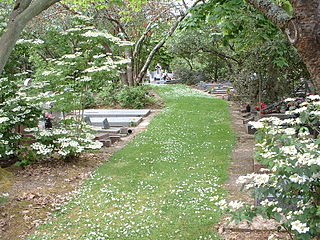
Nantes is a city in the Loire-Atlantique department of France on the Loire, 50 km (31 mi) from the Atlantic coast. The city is the sixth largest in France, with a population of 320,732 in Nantes proper and a metropolitan area of nearly 1 million inhabitants (2020). With Saint-Nazaire, a seaport on the Loire estuary, Nantes forms one of the main north-western French metropolitan agglomerations.

Châteaubriant is a town in western France, about 350 km (220 mi) southwest of Paris, and one of the three sous-préfectures of the Loire-Atlantique department. Châteaubriant is also situated in the historical and cultural region of Brittany, and it is the capital of the Pays de la Mée.

Saintes is a commune and historic town in western France, in the Charente-Maritime department of which it is a sub-prefecture, in Nouvelle-Aquitaine. Saintes is the second-largest city in Charente-Maritime, with 25,518 inhabitants in 2021. The city's immediate surroundings form the second-most populous metropolitan area in the department, with 56,598 inhabitants. While a majority of the surrounding landscape consists of fertile, productive fields, a significant minority of the region remains forested, its natural state.

Bouguenais is a commune in the Loire-Atlantique department in western France near Nantes.

Nantes Cathedral, or the Cathedral of St. Peter and St. Paul of Nantes, is a Roman Catholic Gothic cathedral located in Nantes, Pays de la Loire, France. Construction began in 1434, on the site of a Romanesque cathedral, and took 457 years to finish in 1891. It has been listed since 1862 as a monument historique by the French Ministry of Culture.

Mouzeil is a commune in the Loire-Atlantique department in the Pays de la Loire in western France.

Mathurin Crucy was a French architect and urban planner, who conceived a major Neo-Classical architectural programme for Nantes.

Tours station is a railway station serving the city of Tours, Indre-et-Loire department, western France. It is situated on the Paris–Bordeaux railway, the Tours–Saint-Nazaire railway, and the non-electrified Tours–Le Mans railway. The Gare de Tours is a terminus; most TGV trains only serve the nearby Gare de Saint-Pierre-des-Corps.

The Musée Dobrée is an archeology museum in Nantes, in the quartier Graslin in the immediate outskirts of the city centre and very close to the city's Natural History Museum. It was given to the city by Thomas Dobrée and now belongs to the Conseil général de la Loire-Atlantique. In January 2010, the Conseil général began a project to restructure and modernise the museum, which is planned for completion in 2023.

Amédée-René Ménard was a French academic sculptor and art teacher.
Tugal Caris, also spelled Carris or Cariste, was a 17th-century French ecclesiastical sculptor and ecclesiastical architect who worked in Nantes and Rennes. He was one of the creators of elaborate altarpieces in a new style invented by sculptors from Laval.

The Hôtel de la Marine, originally called Hôtel Massion, is a neo-classical and "neo-Louis-XV" style private mansion built in 1874, located in Nantes, France, at 2 Place Général-Mellinet between the boulevard Paul-Langevin and rue de Belleville, in the Dervallières neighborhood. The building was listed as a French Monument historique in 1988 and 2011.

The Departmental Council of Loire-Atlantique, called the 'General Council of Loire-Inférieure' between 1800 and 1957, then 'General Council of Loire-Atlantique' until 2015, is the deliberative assembly of the French department of Loire-Atlantique. Its headquarters are in Nantes.

Primaudière Priory is an ancient priory dating from the 13th and 18th centuries, located in the French communes of Armaillé in Maine-et-Loire and Juigné-des-Moutiers in Loire-Atlantique.

Rue Alsace-Lorraine is a pedestrian thoroughfare in the French commune of Saintes, in the Charente-Maritime department.

The cemeteries of Nantes have each developed a unique history, with some being more notable than others. Each cemetery has its share of remarkable inhabitants. Since 1979, at least fifteen cemeteries have been operational within the commune of Nantes. The cemeteries of Nantes include Bouteillerie, Chauvinière, Cimetière Parc, Miséricorde, Pont du Cens, Saint-Clair, Saint-Donatien, Saint-Jacques, Saint-Joseph-de-Porterie, Saint-Martin, Sainte-Anne, Toutes-Aides, and Vieux-Doulon.

The Basilica of St. Nicolas in Nantes is a Catholic basilica constructed in the neo-Gothic architectural style, situated in the heart of Nantes. It is one of two basilicas in the city, the other being the Basilica of Saint Donatien and Saint Rogatien.

The former Carmelite Convent at Nantes is a convent of the Carmelite Order established in 1318 in Nantes, France, which was then situated within the Duchy of Brittany. The convent was gradually destroyed beginning with the French Revolution.

The La Bouteillerie Cemetery is a burial site situated in Nantes, France, within the Malakoff-Saint-Donatien neighborhood. The cemetery has been in use since 1774.

The former Jacobins convent in Nantes, France, was constructed in the 13th century and underwent modifications until the 18th century. Only one building, known as "l'Hostellerie des Jacobins", remains from this period. It was situated in the city center, near the Château des Ducs de Bretagne.






















